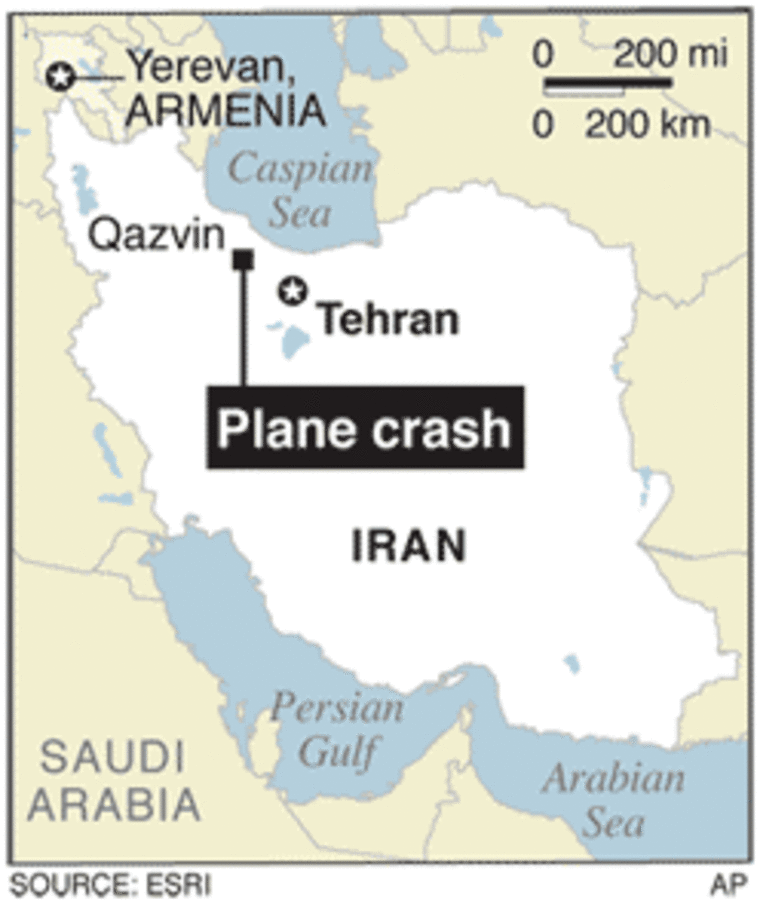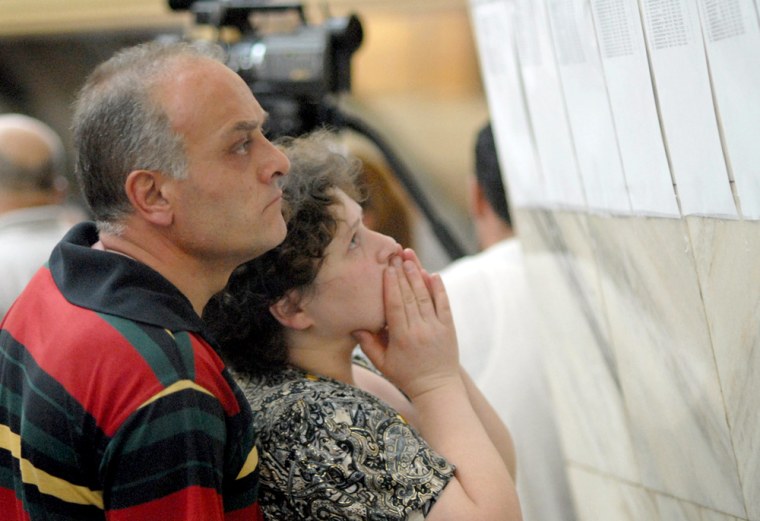A Russian-made jetliner carrying 168 people nose-dived into a field after taking off from the Iranian capital on Wednesday in a fiery crash that shredded the aircraft and killed everyone aboard — Iran's worst air disaster in six years. Witnesses say the plane's tail was on fire before it went down.
It was the latest in a string of deadly crashes in recent years that have highlighted Iran's difficulties in maintaining its aging fleet of planes.
Iranian airlines, including state-run ones, are chronically strapped for cash, and maintenance has suffered, experts say. U.S. sanctions prevent Iran from updating its 30-year-old American aircraft and make it difficult to get European spare parts or planes as well. The country has come to rely on Russian aircraft, many of them Soviet-era planes that are harder to get parts for since the Soviet Union's fall.
The Caspian Airlines Tupolev jet's impact plowed a deep, long trench into agricultural fields outside the village of Jannat Abad, and the aircraft was blasted to bits. Flaming wreckage, body parts and personal items were strewn over a 200-yard (meter) area. Firefighters put out blazes from the crash, but smoke smoldered from the pit for hours after as emergency workers searched for data recorders and other clues to the cause.
Ali Akbar Hashemi, a 23-year-old, was laying gas pipes in a house by the field when he saw the stricken jet overhead. He said the plane was circling in the air, flames shooting from its tail section.
"Then, I saw the plane crashing nose-down. It hit the ground causing a big explosion. The impact shook the ground like an earthquake," Hashemi told The Associated Press by phone.

Plane crashes moments after takeoff
The Tu-154M jet had taken off from Tehran's Imam Khomeini International Airport on Wednesday morning and was headed to the Armenian capital Yerevan. It crashed at 11:30 am about 16 minutes after takeoff outside Jannat Abad, near the city of Qazvin, around 75 miles northwest of Tehran, civil aviation spokesman Reza Jafarzadeh told state media.
At Yerevan's airport, Tina Karapetian, 45, sobbed and said she had been waiting for her sister and the sister's 6- and 11-year-old sons, who were due on the flight.
"What will I do without them?" she cried before collapsing to the floor.
The cause of the crash was not immediately known.
The plane was carrying 153 passengers and 15 crewmembers, Jafarzadeh and the deputy chairman of Armenia's civil aviation authority Arsen Pogosian said. "In all likelihood, all on board were killed," Pogosian told reporters at Yerevan airport.
Most of the passengers were Iranians, many of them from Iran's large ethnic Armenian community, as well as 11 members of Iran's national youth judo team. Five Armenian citizens were among the dead, Armenia's Foreign Ministry said in a statement, along with two Georgians, including a staffer from the Caucasus nation's embassy in Yerevan.
Failed emergency landing
Serob Karapetian, the chief of Yerevan airport's aviation security service, said the plane may have attempted an emergency landing, but reports that it caught fire in the air were "only one version." He did not elaborate. A police officer told Iran's semi-official ISNA news agency that several witnesses reported seeing the plane's tail on fire.
The Tupolev's three engines are in its tail section. The flames there could indicate "an uncontained engine failure," said Patrick Smith, a pilot and the air travel and safety writer for Salon.com.
But he said it's too early to tell. The crash's root cause could be elsewhere, and the flames a sign of a compressor stall caused when the plane went out of control, interrupting airflow through the engine, Smith said.
The crash is Iran's worst since February 2003, when a Russian-made Ilyushin 76 carrying members of the elite Revolutionary Guards crashed in the mountains of southeastern Iran, killing 302 people aboard. That crash was a sign of how maintenance problems have also affected Iran's military.
Caspian Airlines is an Iranian-Russian private joint venture founded in 1993, with a fleet of Tu-154s built between 1989 and 1993. Russia produced 900 Tu-154s until production was halted in 1996.
Concerns over maitenance
The average age of Iran's fleet of aircraft is 22 years, said Masoud Mohajer, an aviation expert in Tehran. Age itself may not be a problem — even older jets are in service around the world — but keeping them maintained is. Mohajer said Iranian airlines can't afford to keep even Russian planes in shape because of lack of government support.
He pointed to "the financial inability to buy new planes or carry out maintenance requirements."
"Iranian airliners don't have enough cash even to buy new Russian planes. The government controls ticket prices. It's not profitable for airliners," Mohajer said.
Some of the jets in Iran's fleet are U.S.-made craft bought before the 1979 Islamic Revolution, which led to a cut-off in ties between the nations. U.S. sanctions since prevent Iran from buying parts for those planes or new ones.
In December 2005, 115 people were killed when a pre-1979 U.S.-made C-130 plane, crashed into a 10-story building near Tehran's Mehrabad airport.
Sanctions interfere with safety
The sanctions also bar sales of European jets with a certain amount of U.S. parts, limiting Iran's ability to buy from Europe.
As a result, Iran has focused on Russian-built planes — like the Tupolev and Ilyushins, the Soviet-era workhorses for Russian civil air fleets. After the Soviet collapse, government funding sharply declined for manufacturers of aircraft and spare parts, and other countries using the planes have had a harder time getting parts.
There have been two other fatal crashes involving Tu-154s in Iran since 2002 that killed 128 people.
"There is a big question about the availability of spares for aircraft generally in Iran," said Chris Yates, a Britain-based aviation analyst. The Iranians may have turned to buying spares produced locally or from the black market, he said.
Smith said Russian aircraft suffer from a somewhat undeserved bad reputation — their "less impressive" record is in part because they have historically been used in harsher environments than Western models, like arctic areas, and by airlines in developing countries where safety standards aren't as strict.
"The plane is only as safe as how it's operated and maintained and how well trained its crewmembers are," he said.
More on Iran
